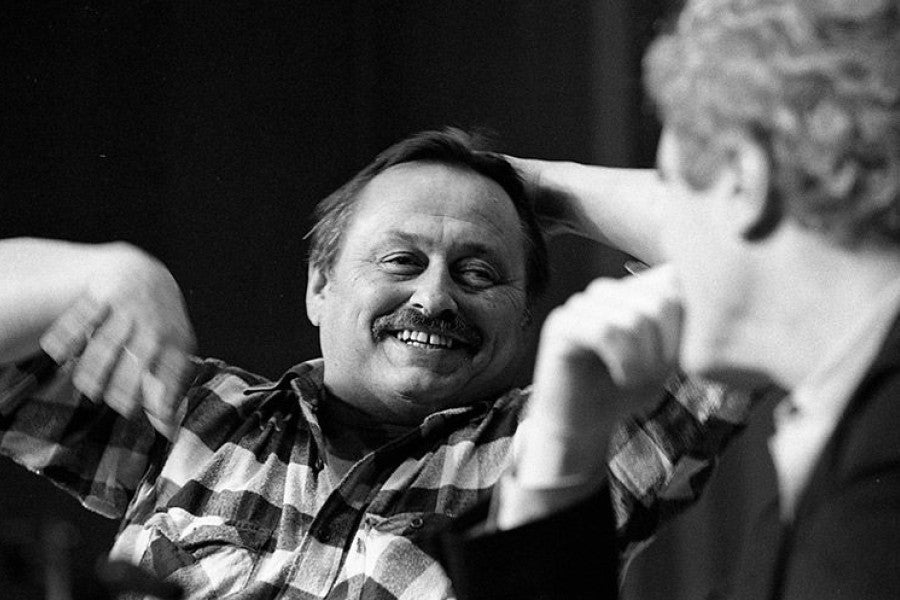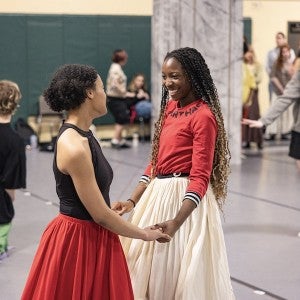Interlochen Online's next session begins May 6—enroll in any course or certificate program now.
Interlochen remembers Jim Harrison
A look back at Northern Michigan author and poet Jim Harrison's 1986 visit to Interlochen Center for the Arts.
During a 1986 visit to Interlochen Center for the Arts author and poet Jim Harrison revealed to an audience of ardent students and faculty members his adoration for Stravinsky's Petrushka. That as an 18-year-old farmhand how he would hum the tune to himself while "...hoeing corn all day," as a way to pass the time.
Perhaps it wasn't just Stravinsky's score that attracted Harrison to Petrushka. The ballet tells the tragic tale of a love triangle between three enchanted Russian puppets in dreary 19th century St. Petersburg. Woven into Petrushka's four tableaux are studies on attraction, fateful encounters, environment and gallows humor. All of which are thematic elements commonly found in many of Harrison's works crafted throughout his nearly five-decades-long career.
Over the years, much has been said about Harrison's appetite in the literal and figurative senses of the word. Harrison's passions uniquely had the breadth and depth that would allow a farm boy from a small town in Northern Michigan to earnestly and authentically connect his life to a then nearly half-century-old Russian ballet. As former Interlochen Center for the Arts Creative Writing Director Mike Delp put it, "[Jim Harrison] was a consumer of the world." Harrison's voracious appetite afforded him the wisdom to draw such parallels in his writings. Delp added that, "Students gravitated to his work," and despite his commanding demeanor found Harrison approachable and generous during this 1986 visit.
Back at the podium, the audience listened as this half-blind, denim-clad everyman reflected in his grizzly voice, "I don't think that the other farm workers were thinking of Petrushka," before wading into a reading about the forlorn puppet from his collected work Letters To Yesenin.
It was this astute intellectualism and self-deprecation that resonated throughout the many eulogies and retrospectives that went online after the news of Harrison's passing spread on March 26, 2016. The outpouring of sympathy began almost immediately with articles in The New Yorker, Outside Magazine, The New York Times and Esquire. It was Harrison's versatility and consistent quality as a writer that led Delp to proclaim that Harrison had "no equal."
"Being a writer was not a rarified thing for him," reflected former Interlochen Center for the Arts Creative Writing instructor Jack Driscoll. "He was not part of the establishment." Driscoll met Harrison early on in his career as a writer and Interlochen faculty member. To Driscoll, this 1986 visit to Interlochen was no different from any of their previous encounters. Driscoll recalled that Harrison affably controlled conversations with faculty members, students and friends with "an innate instinct and intelligence."
During his two-day trip to Interlochen, when Harrison spoke students listened out of respect and awe. As Driscoll put it, "Students were silent because they knew that they were lucky to be in the presence of someone so special." For those that knew or studied Harrison, that reverence is still felt after his passing.
As the spirit of Petrushka lingers over the stage at the end of Stravinsky's ballet, so too remains the impact Jim Harrison left not just on Interlochen and Northern Michigan, but on the artistic world at large.
Audio from Jim Harrison's 1986 Interlochen Arts Academy interview conducted by author Mark Strand and a segment of his reading can be found below.
A special thanks to Mike Delp and Jack Driscoll for contributing to this story.







